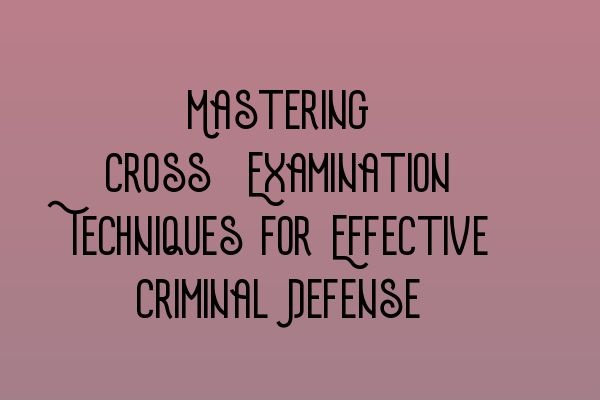Mastering Cross-Examination Techniques for Effective Criminal Defense
Welcome to SQE Criminal Law & Practice Law UK! In today’s blog post, we will dive deep into the art of cross-examination and explore the techniques that will help you become a master of this crucial aspect of criminal defense. Cross-examination is a powerful tool that allows defense lawyers to challenge the credibility and accuracy of witnesses presented by the prosecution. It is an opportunity to uncover inconsistencies, biases, and weaknesses in the prosecution’s case, ultimately working towards achieving a favorable outcome for your client.
The Importance of Cross-Examination
Effective cross-examination can make or break a criminal defense case. It is during this stage of the trial that the defense attorney has the opportunity to test the veracity of the prosecution’s evidence and expose any flaws. Through strategic questioning and careful analysis of the witness’s responses, the defense attorney can cast doubt on the credibility of the witness and the prosecution’s case as a whole.
To master cross-examination, it is crucial to have a deep understanding of the case, the witness statements, and the key issues at hand. Thorough preparation and meticulous attention to detail are essential. By familiarizing yourself with the facts, anticipating potential responses, and developing a solid strategy, you can effectively challenge the prosecution’s narrative and strengthen your position.
Key Techniques for Effective Cross-Examination
1. Impeachment: This technique involves confronting the witness with prior inconsistent statements, contradictions, or bias to discredit their testimony. By systematically presenting evidence that challenges the witness’s credibility, you can undermine the prosecution’s case.
2. Leading Questions: Through the use of leading questions, you can guide witnesses towards providing answers that support your defense strategy. By controlling the narrative and ensuring the witness provides favorable responses, you can effectively influence the jury’s perception of the case.
3. Controlling the Witness: It is important to maintain control over the witness during cross-examination. By using confident body language, assertive tone, and strategic pauses, you can assert authority and create an environment conducive to obtaining the desired information.
4. Thematic Approach: Organizing your cross-examination around key themes and issues helps to present a coherent and compelling defense. By structuring your questioning in a logical and memorable manner, you can reinforce the defense’s central arguments.
5. Active Listening: Paying close attention to the witness’s responses is crucial during cross-examination. By actively listening, you can identify opportunities for follow-up questions, clarification, or inconsistencies. This allows you to effectively exploit weaknesses in the prosecution’s case.
Remember, practice makes perfect! Utilize SQE 1 Practice Exam Questions and SQE 1 Practice Mocks FLK1 FLK2 to hone your skills and improve your cross-examination techniques. Additionally, consider enrolling in SQE 2 Preparation Courses and SQE 1 Preparation Courses to receive comprehensive training and guidance for the SQE exams.
Conclusion
Cross-examination is an integral part of a criminal defense lawyer’s arsenal. By mastering the art of cross-examination, you can effectively challenge the prosecution’s case and advocate for your client’s rights. Remember to approach cross-examination with confidence, thorough preparation, and a strategic mindset. By implementing the techniques discussed in this article and utilizing the available resources, you will be on your way to becoming a formidable defense attorney.
Stay tuned to our blog for more valuable insights and updates on criminal law and practice. For the latest information on SRA SQE exam dates, visit SRA SQE Exam Dates.
